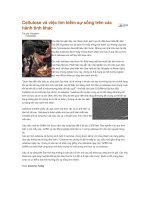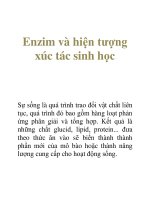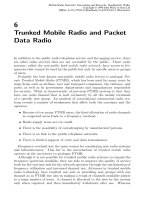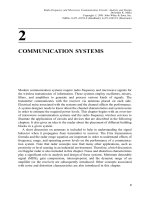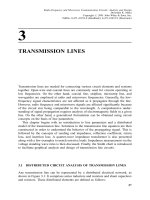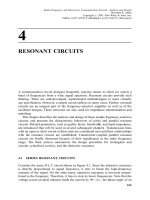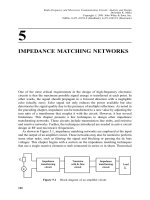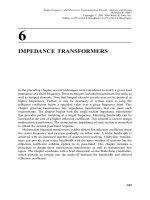Tài liệu RF và mạch lạc lò vi sóng P6 ppt
Bạn đang xem bản rút gọn của tài liệu. Xem và tải ngay bản đầy đủ của tài liệu tại đây (436.2 KB, 54 trang )
6
IMPEDANCE TRANSFORMERS
In the preceding chapter, several techniques were considered to match a given load
impedance at a ®xed frequency. These techniques included transmission line stubs as
well as lumped elements. Note that lumped-element circuits may not be practical at
higher frequencies. Further, it may be necessary in certain cases to keep the
re¯ection coef®cient below a speci®ed value over a given frequency band. This
chapter presents transmission line impedance transformers that can meet such
requirements. The chapter begins with the single-section impedance transformer
that provides perfect matching at a single frequency. Matching bandwidth can be
increased at the cost of a higher re¯ection coef®cient. This concept is used to design
multisection transformers. The characteristic impedance of each section is controlled
to obtain the desired pass-band response.
Multisection binomial transformers exhibit almost ¯at re¯ection coef®cient about
the center frequency and increase gradually on either side. A wider bandwidth is
achieved with an increased number of quarter-wave sections. Chebyshev transfor-
mers can provide even wider bandwidth with the same number of sections but the
re¯ection coef®cient exhibits ripples in its pass-band. This chapter includes a
procedure to design these multisection transformers as well as transmission line
tapers. The chapter concludes with a brief discussion on the Bode-Fano constraints,
which provide an insight into the trade-off between the bandwidth and allowed
re¯ection coef®cient.
189
Radio-Frequency and Microwave Communication Circuits: Analysis and Design
Devendra K. Misra
Copyright # 2001 John Wiley & Sons, Inc.
ISBNs: 0-471-41253-8 (Hardback); 0-471-22435-9 (Electronic)
6.1 SINGLE SECTION QUARTER-WAVE TRANSFORMER
We considered a single-section quarter-wavelength transformer design problem
earlier in Example 3.5. This section presents a detailed analysis of such circuits.
Consider the load resistance R
L
that is to be matched with a transmission line of
characteristic impedance Z
o
. Assume that a transmission line of length ` and
characteristic impedance Z
1
is connected between the two, as shown in Figure
6.1. Its input impedance Z
in
is found as follows.
Z
in
Z
1
R
L
jZ
1
tanb`
Z
1
jR
L
tanb`
6:1:1
For b` 90
(i.e., ` l=4 ) and Z
1
Z
o
R
L
p
; Z
in
is equal to Z
o
and, hence,
there is no re¯ected wave beyond this point toward the generator. However, it
reappears at other frequencies when b` T 90
. The corresponding re¯ection
coef®cient G
in
can be determined as follows.
G
in
Z
in
À Z
o
Z
in
Z
o
Z
1
R
L
jZ
1
tanb`
Z
1
jR
L
tanb`
À Z
o
Z
1
R
L
jZ
i
tanb`
Z
1
jR
L
tanb`
Z
o
R
L
À Z
o
R
L
Z
o
j2
Z
o
R
L
p
tanb`
r
in
exp jj
; r
in
R
L
À Z
o
fR
L
Z
o
2
4Z
o
R
L
tan
2
b`g
1=2
1
1
2
Z
o
R
L
p
R
L
À Z
o
secb`
!
2
8
<
:
9
=
;
1=2
6:1:2
Figure 6.1 A single-section quarter-wave transformer.
190
IMPEDANCE TRANSFORMERS
Variation in r
in
with frequency is illustrated in Figure 6.2. For b` near 90
, it can
be approximated as follows:
r
in
%
jR
L
À z
o
j
2
Z
o
R
L
p
tanb`
%
jR
L
À Z
o
j
2
Z
o
R
L
p
cosb`6:1:3
If r
M
is the maximum allowable re¯ection coef®cient at the input, then
cosy
1
2r
M
Z
o
R
L
p
R
L
À Z
o
1 À r
2
M
p
; y
1
< p=2 6:1:4
In the case of a TEM wave propagating on the transmission line, b`
p
2
Â
f
f
o
,
where f
o
is the frequency at which b`
p
2
. In this case, the bandwidth
( f
2
À f
1
Df is given by
Df f
2
À f
1
2 f
o
À f
1
2 f
o
À
2f
o
p
y
1
6:1:5
and the fractional bandwidth is
Df
f
o
2 À
4
p
cos
À1
2r
M
Z
o
R
L
p
R
L
À Z
o
1 À r
2
M
p
6:1:6
Figure 6.2 Re¯ection coef®cient characteristics of a single section impedance transformer
used to match a 100-O load to a 50-O line.
SINGLE SECTION QUARTER-WAVE TRANSFORMER
191
Example 6.1: Design a single-section quarter-wave impedance transformer to
match a 100-O load to a 50-O air-®lled coaxial line at 900 MHz. Determine the
range of frequencies over which the re¯ection coef®cient remains below 0.05.
For R
L
100 O and Z
o
50 O
Z
1
100 Â 50
p
70:7106781 O
and,
`
l
4
3 Â 10
8
4 Â 900 Â 10
6
m 8:33 cm
Magnitude of the re¯ection coef®cient increases as b` changes from p=2 (i.e., the
signal frequency changes from 900 MHz). If the maximum allowed r is
r
M
0:05VSWR 1:1053, then fractional bandwidth is found to be
Df
f
o
2 À
4
p
cos
À1
2r
M
Z
o
R
L
p
R
L
À Z
o
1 À r
2
M
p
0:180897
Therefore, 818.5964 MHz f 981.4037 MHz or 1.4287 b` 1.7129.
6.2MULTI-SECTION QUARTER-WAVE TRANSFORMERS
Consider an N-section impedance transformer connected between a transmission line
of characteristic impedance of Z
o
and load R
L
, as shown in Figure 6.3. As indicated,
the length of every section is the same while their characteristic impedances are
different. Impedance at the input of Nth section can be found as follows:
Z
N
in
Z
N
exp jb`G
N
expÀjb`
exp jb`ÀG
N
expÀjb`
6:2:1
where
G
N
R
L
À Z
N
R
L
Z
N
6:2:2
192
IMPEDANCE TRANSFORMERS
The re¯ection coef®cient seen by the (N-1)st section is
G
H
NÀ1
Z
N
in
À Z
NÀ1
Z
N
in
Z
NÀ1
Z
N
e
jb`
G
N
e
Àjb`
ÀZ
NÀ1
e
jb`
À G
N
e
Àjb`
Z
N
e
jb`
G
N
e
Àjb`
Z
NÀ1
e
jb`
À G
N
e
Àjb`
or,
G
H
NÀ1
Z
N
À Z
NÀ1
e
jb`
G
N
Z
N
Z
NÀ1
e
Àjb`
Z
N
Z
NÀ1
e
jb`
G
N
Z
N
À Z
NÀ1
e
Àjb`
Therefore,
G
H
NÀ1
G
NÀ1
G
N
e
Àj2b`
1 G
N
G
NÀ1
e
Àj2b`
6:2:3
where
G
NÀ1
Z
N
À Z
NÀ1
Z
N
Z
NÀ1
6:2:4
If Z
N
is close to R
L
and Z
NÀ1
is close to Z
N
, then G
N
and G
NÀ1
are small
quantities, and a ®rst-order approximation can be assumed. Hence,
G
H
NÀ1
% G
NÀ1
G
N
e
Àj2b`
6:2:5
Similarly,
G
H
NÀ2
% G
NÀ2
G
H
N
e
Àj2b`
G
NÀ2
G
NÀ1
e
Àj2b`
G
N
e
Àj4b`
Figure 6.3 An N-section impedance transformer.
MULTI-SECTION QUARTER-WAVE TRANSFORMERS
193
Therefore, by induction, the re¯ection coef®cient seen by the feeding line is
G % G
0
G
1
e
Àj2b`
G
2
e
Àj4b`
ÁÁÁG
NÀ1
e
Àj2NÀ1b`
G
N
e
Àj2N b`
6:2:6
or,
G
P
N
n0
G
n
e
Àj2nb`
6:2:7
where
G
n
Z
n1
À Z
n
Z
n1
Z
n
6:2:8
Thus, we need a procedure to select G
n
so that G is minimized over the desired
frequency range. To this end, we recast the above equation as follows:
G G
0
G
1
w G
2
w
2
ÁÁÁG
N
w
N
G
N
Q
N
n1
w À w
n
6:2:9
where
j À2b` 6:2:10
and,
w e
jj
6:2:11
Note that for b` 0 (i.e., l 3I), individual transformer sections in effect have
no electrical length and load R
L
appears to be directly connected to the main line.
Therefore,
G
P
N
n0
G
n
R
L
À Z
o
R
L
Z
o
; , w 16:2:12
and, only N of the N 1 section re¯ection coef®cients can be selected indepen-
dently.
194
IMPEDANCE TRANSFORMERS
6.3 TRANSFORMER WITH UNIFORMLY DISTRIBUTED SECTION
REFLECTION COEFFICIENTS
If all of the section re¯ection coef®cients are equal then (6.2.9) can be simpli®ed as
follows:
G
G
N
1 w w
2
w
3
ÁÁÁw
NÀ1
w
N
w
N1
À 1
w À 1
6:3:1
or,
G
G
N
e
jN1j
À 1
e
jj
À 1
e
jNj=2
sin
N 1
2
j
sin
j
2
Hence,
jGjrjr
N
sin
N 1
2
j
sin
j
2
N 1r
N
sin
N 1
2
j
N 1 sin
j
2
6:3:2
and, from (6.2.12),
P
N
n0
G
n
N 1r
N
R
L
À Z
o
R
L
Z
o
6:3:3
Therefore, equation (6.3.2) can be written as follows:
rb`
R
L
À Z
o
R
L
z
o
Á
sinfN 1b`g
N 1 sinb`
6:3:4
This can be viewed as an equation that describes magnitude r of the re¯ection
coef®cient as a function of frequency. As (6.3.4) indicates, a pattern of rb` repeats
periodically with an interval of p. It peaks at np, where n is an integer including
zero. Further, there are N À 1 minor lobes between two consecutive main peaks. The
number of zeros between the two main peaks of rb` is equal to the number of
quarter-wave sections, N.
Consider that there are three quarter-wave sections connected between a 100-ohm
load and a 50-ohm line. Its re¯ection coef®cient characteristics can be found from
(6.3.4), as illustrated in Figure 6.4. There are three zeros in it, one at b` p=2 and
the other two symmetrically located around this point. In other words, zeros occur at
b` p=4, p=2, and 3p=4. When the number of quarter-wave sections is increased
from 3 to 6, the rb` plot changes as illustrated in Figure 6.5.
UNIFORMLY DISTRIBUTED SECTION REFLECTION COEFFICIENTS
195
For a six-section transformer, Figure 6.5 shows ®ve minor lobes between two
main peaks of rb`. One of these minor lobes has its maximum value (peak) at
b` p=2. Six zeros of this plot are symmetrically located, b` np=7,
n 1; 2; ...; 6. Thus, characteristics of rb` can be summarized as follows:
Pattern of rb` repeats with an interval of p.
There are N nulls and (N À 1) minor peaks in an interval.
Figure 6.4 Re¯ection coef®cient versus b` of a three-section transformer with equal section
re¯ection coef®cients for R
L
100 O and Z
o
50 O.
Figure 6.5 Re¯ection coef®cient versus b` for a six-section transformer with equal section
re¯ection coef®cients (R
L
100 O and Z
o
50 O).
196
IMPEDANCE TRANSFORMERS
When N is odd, one of the nulls occurs at b` p=2 (i.e., ` l=4).
If r
M
is speci®ed as an upper bound on r to de®ne the frequency band then
points P
1
and P
2
bound the acceptable range of b`. This range becomes larger
as N increases.
Since
w
N1
À 1
Y
N
n0
w À w
n
6:3:5
where
w
n
e
j
2pn
N1
; n 1; 2; ...; N 6:3:6
(6.3.1) may be written as follows:
G
G
N
Y
N
n1
w À w
n
Y
N
n1
w À e
j
2pn
N1
6:3:7
This equation is of the form of (6.2.9). It indicates that when section re¯ection
coef®cients are the same, roots are equispaced around the unit circle on the complex
w-plane with the root at w 1 deleted. This is illustrated in Figure 6.6 for N 3. It
follows that
r
r
N
Y
N
n1
w À e
j
2pn
N1
Y
N
n1
w À e
j
2pn
N1
6:3:8
Figure 6.6 Location of zeros on a unit circle on the complex w-plane for N 3.
UNIFORMLY DISTRIBUTED SECTION REFLECTION COEFFICIENTS
197
Since w e
jj
is constrained to lie on the unit circle, distance between w and w
n
is
given by
d
n
j e
jj
À e
j
2pn
N1
6:3:9
For the case of N 3, d
n
j 0) is illustrated in Figure 6.7. From (6.3.3), (6.3.8),
and (6.3.9), we get
rj
1
N 1
R
L
À Z
o
R
L
Z
o
Y
N
n1
d
n
j6:3:10
Thus, as j À2b` varies from 0 to 2 p, w e
jj
makes one complete traverse of
the unit circle, and distances d
1
; d
2
; ...; d
N
vary with j.Ifw coincides with the root
w
n
, then the distance d
n
is zero. Consequently, the product of the distances is zero.
Since the product of these distances is proportional to the re¯ection coef®cient,
rj
n
goes to zero. It attains a local maximum whenever w is approximately halfway
between successive roots.
Example 6.2: Design a four-section quarter-wavelength impedance transformer
with uniform distribution of re¯ection coef®cient to match a 100-O load to a 50-O
air-®lled coaxial line at 900 MHz. Determine the range of frequencies over which the
re¯ection coef®cient remains below 0.1. Compare this bandwidth with that obtained
for a single-section impedance transformer.
Figure 6.7 Graphical representation of (6.3.9) for N 3 and j 0.
198
IMPEDANCE TRANSFORMERS
From (6.3.3) with N 4wehave
G
4
1
5
100 À 50
100 50
1
15
and, from (6.2.2),
1
15
100 À Z
4
100 Z
4
or,
100 Z
4
1500 À 15 Á Z
4
A 16Á Z
4
1400 A Z
4
87:5 O
Characteristic impedance of other sections can be determined from (6.2.8) as
follows:
1
15
Z
4
À Z
3
Z
4
Z
3
A 87:5 Z
3
15 Á 87:5 À 15 Á Z
3
A Z
3
76:5625 O
1
15
Z
3
À Z
2
Z
3
Z
2
A Z
2
14 Á 76:5625
16
66:9922 O % 67 O
and,
1
15
Z
2
À Z
1
Z
2
Z
1
A Z
1
14 Á 67
16
58:625 O
The frequency range over which re¯ection coef®cient remains below 0.1 is
determined from (6.3.4) as follows:
0:1
1
3
Â
sin5 Á y
m
5 Á siny
m
A
sin5 Á y
m
siny
m
1:5
where y
m
represents the value of b` at which magnitude of re¯ection coef®cient is
equal to 0.1.
This is a transcendental equation that can be graphically solved. To that end, one
needs to plot j sin5y
m
j and 1:5j siny
m
j versus y
m
on the same graph and lookfor
the intersection of two curves. Alternatively, a numerical method can be employed to
determine y
m
. Two solutions to this equation are found to be 0.476 and 2.665,
respectively. Hence,
0:476 b` 2:665 or 272:7MHz f 1:5269 Ghz
UNIFORMLY DISTRIBUTED SECTION REFLECTION COEFFICIENTS
199
Corresponding bandwidth with a single section can be evaluated as follows:
1:2841 b` 1:8575 or 735:74 MHz f 1:0643 GHz
Re¯ection coef®cient characteristics for two cases are displayed in Figure 6.8.
Clearly, it has much wider bandwidth with four sections in comparison with that of a
single section.
6.4 BINOMIAL TRANSFORMERS
As shown in Figures 6.4 and 6.5, there are peaks and nulls in the pass-band of a
multisection quarter-wavelength transformer with uniform section re¯ection coef®-
cients. This characteristic can be traced to equispaced roots on the unit circle. One
way to avoid this behavior is to place all the roots at a common point w equal to À1.
With this setting, distances d
n
are the same for all cases and
Q
N
n1
w À w
n
goes to
zero only once. It occurs for j equal to Àp, i.e., at b` p=2. Thus, r is zero only
for the frequency at which each section of the transformer is l=4 long. With
w
n
À1 for all n, equation (6.2.9) may be written as follows.
G
G
N
Q
N
n1
w À w
n
w 1
N
P
N
m0
N!
m!N À m!
w
m
6:4:1
Figure 6.8 Re¯ection coef®cient versus b` for a four-section (N 4) and a single-section
(N 1) impedance transformer.
200
IMPEDANCE TRANSFORMERS
The following binomial expansion is used in writing (6.4.1).
1 x
m
P
N
n1
m!
n!m À n!
x
n
A comparison of equation (6.4.1) with (6.2.7) indicates that
G
n
G
N
N !
n!N À n!
; n 0; 1; 2; ...; N : 6:4:2
and therefore, the section re¯ection coef®cients, normalized to G
N
, are binomially
distributed.
From equation (6.4.1),
G G
N
w 1
N
A Gb`G
N
e
Àj2b`
1
N
G
N
2
N
e
ÀjNb`
cosb`
N
or,
rb`r
N
2
N
j cosb`j
N
6:4:3
For b` 0, load R
L
is effectively connected to input line. Therefore,
r0r
N
2
N
R
L
À Z
o
R
L
Z
o
6:4:4
and,
rb`
R
L
À Z
o
R
L
Z
o
Âjcosb`j
N
6:4:5
Re¯ection coef®cient characteristics of multisection binomial transformers versus
b` (in degrees) are illustrated in Figure 6.9. Re¯ection coef®cient scale is normal-
ized with the load re¯ection coef®cient r
L
. Unlike the preceding case of uniformly
distributed section re¯ection coef®cients, it shows a smooth characteristic without
lobes.
Example 6.3: Design a four-section quarter-wavelength binomial impedance trans-
former to match a 100-O load to a 50-O air-®lled coaxial line at 900 MHz.
Determine the range of frequencies over which the re¯ection coef®cient remains
below 0.1. Compare this result with that obtained in Example 6.2.
BINOMIAL TRANSFORMERS
201
With N 4 and n 0, 1, and 2 in (6.4.2), we get
G
0
G
4
4!
0!4!
G
4
G
4
A G
0
G
4
G
1
G
4
4!
1!3!
G
3
G
4
A G
1
G
3
4 Â G
4
and,
G
2
G
4
4!
2!2!
6 A G
2
6 Â G
4
From (6.4.4),
r0r
N
2
N
R
L
À Z
o
R
L
Z
o
A r
4
1
2
4
100 À 50
100 50
1
48
0:020833
and from (6.2.8),
G
n
Z
n1
À Z
n
Z
n1
Z
n
A r
n
Z
n1
Z
n
Z
n1
À Z
n
Therefore,
Z
n
1 À r
n
1 r
n
 Z
n1
6:4:6
Figure 6.9 Re¯ection coef®cient versus b` for a multisection binomial transformer.
202
IMPEDANCE TRANSFORMERS
Alternatively,
Z
n1
1 r
n
1 À r
n
 Z
n
6:4:7
Characteristic impedance of each section can be determined from (6.4.6), as
follows:
Z
4
1 À
1
48
1
1
48
 100 95:9184 O
Z
3
1 À
4
48
1
4
48
 95:9184 81:1617 O
Z
2
1 À
6
48
1
6
48
 81:1617 63:1258 O
and,
Z
1
1 À
4
48
1
4
48
 63:1258 53:4141 O
If we continue with this formula, we ®nd that
Z
o
1 À
1
48
1
1
48
 53:4141 51:2339 O
This is different from the given value of 50 O. It happened because of
approximation involved in the formula. Error keeps building up if the characteristic
impedances are determined proceeding just one way. In order to minimize it,
common practice is to determine the characteristic impedances up to half-way
proceeding from the load side and then the remaining half from the input side. Thus,
Z
1
and Z
2
should be determined from (6.4.7), as follows:
Z
1
1
1
48
1 À
1
48
 50 52:1277 O
BINOMIAL TRANSFORMERS
203
and,
Z
2
1
4
48
1 À
4
48
 50 61:6054 O
The frequency range over which the re¯ection coef®cient remains below 0.1 can
be determined from (6.4.5) as follows.
0:1
1
3
j cosW
M
j
4
A W
M
0:7376
Therefore,
0:7376 b` 2:404; or 422:61 MHz f 1:3774 GHz
Clearly, it has larger frequency bandwidth in comparison with that of a single
section. However, it is less than the bandwidth obtained with uniformly distributed
section re¯ection coef®cients. Re¯ection coef®cient as a function of b` is illustrated
in Figure 6.10.
Figure 6.10 Re¯ection coef®cient of a four-section binomial transformer versus b`.
204
IMPEDANCE TRANSFORMERS
6.5 CHEBYSHEV TRANSFORMERS
Consider again the case of a uniform three-section impedance transformer that is
connected between a 50-ohm line and 100-ohm load. Distribution of zeros around
the unit circle is shown in Figure 6.11 with solid points. Its frequency response is
illustrated in Figure 6.12 as curve (a). Now, let us move two of these zeros to Æ120
while keeping the remaining one ®xed at 180
, as illustrated by un®lled points in
Figure 6.11. With this change in the distribution of zeros on the complex w-plane,
rb` versus b` varies as shown by curve (b) in Figure 6.12. It shows relatively
much lower peaks of intervening lobes while widths as well as heights of the two
main lobes increase. On the other hand, if we move the two zeros to Æ60
then the
main peaks go down while intervening lobes rise. This is illustrated by hatched
points in Figure 6.11 and by curve (c) in Figure 6.12. In this case, minor lobes
increase while the main lobes reduce in size. Note that zeros in this case are
uniformly distributed around the unit circle and, therefore, its rb` characteristic
has identical lobes.
Thus, the heights of intervening lobes decrease at the cost of the main lobe when
zeros are moved closer together. On the other hand, moving the zeros farther apart
raises the level of intervening lobes but reduces the main lobe. However, we need a
systematic method to determine the location of each zero for a maximum permis-
sible re¯ection coef®cient, r
M
, and the number of quarter-wave sections, N.An
optimal distribution of zeros around the unit circle will keep peaks of all pass-band
lobes at the same height of r
M
.
In order to have magnitudes of all minor lobes in the pass-band equal, section
re¯ection coef®cients are determined by the characteristics of Chebyshev functions,
Figure 6.11 Distribution of zeros for a uniform three-section impedance transformer (solid),
with two of those zeros moved to Æ120
(un®lled), or to Æ60
(hatched).
CHEBYSHEV TRANSFORMERS
205
named after a Russian mathematician who ®rst studied them. These functions satisfy
the following differential equation:
1 À x
2
d
2
T
m
x
dx
2
À x
dT
m
x
dx
m
2
T
m
x0 6:5:1
Chebyshev functions of degree m, represented by T
m
x, are mth degree poly-
nomials that satisfy (6.5.1). The ®rst four of these and a recurrence relation for
higher-order Chebyshev polynomials are given as follows:
T
1
xx
T
2
x2x
2
À 1
T
3
x4x
3
À 3x
T
4
x8x
4
À 8x
2
1
:
:
T
m
x2xT
mÀ1
xÀT
mÀ2
x
Alternatively,
T
m
x
cosm cos
À1
x À 1 x 1
coshm cosh
À1
xx ! 1
À1
m
coshm cosh
À1
jxjx À1
8
<
:
6:5:2
Figure 6.12 Re¯ection coef®cient versus j for (a) a uniform three-section transformer,
(b) two zeros moved to Æ120
, and (c) two zeros moved to Æ60
.
206
IMPEDANCE TRANSFORMERS
Note that, for x cosy,
T
m
cosy cosmy6:5:3
Figure 6.13 depicts Chebyshev polynomials of degree 1 through 4. The following
characteristics can be noted from it.
Magnitudes of these polynomials oscillate between Æ1 for À1 x 1.
For jxj > 1, jT
m
xj increases at a faster rate with x as m increases.
Numbers of zeros are equal to the order of polynomials. Zeros of an even-order
polynomial are symmetrically located about the origin, with one of the minor
lobes' peakat x 0.
Polynomials of odd orders have one zero at x 0 while the remaining zeros
are symmetrically located.
These characteristics of Chebyshev polynomials are utilized to design an
impedance transformer that has ripples of equal magnitude in its pass-band. The
number of quarter-wave sections determines the order of Chebyshev polynomials
and the distribution of zeros on the complex w-plane is selected according to that.
With x
o
properly selected, jT
m
xj precisely corresponds to rb`. This is done by
linking b` to x of Chebyshev polynomial as follows.
x x
o
cosb`6:5:4
Consider the design of a three-section equal-ripple impedance transformer. A
Chebyshev polynomial of order three is appropriate for this case. Figure 6.14
Figure 6.13 Chebyshev polynomials for m 1; 2; 3; 4.
CHEBYSHEV TRANSFORMERS
207
illustrates T
3
x together with (6.5.4). Note that Chebyshev variable x and angle j on
the complex w-plane are related through (6.5.4) because j is equal to À2b`.Asj
varies from 0 to À2p, x changes as illustrated in Figure 6.14 (b) and the
corresponding T
3
x in Figure 6.14 (a). Figure 6.15 shows jT
3
jj which can
represent the desired rj provided that
T
3
j 0
1
T
3
x
o
1
jR
L
À Z
o
=R
L
Z
o
j
r
M
6:5:5
where r
M
is the maximum allowed re¯ection coef®cient in the pass-band.
For an m-section impedance transformer, (6.5.5) can be written as follows:
T
m
x
o
R
L
À Z
o
R
L
Z
o
Â
1
r
M
6:5:6
Location x
o
can now be determined from (6.5.2) as follows:
x
o
cosh
1
m
 cosh
À1
T
m
x
o
6:5:7
Figure 6.14 Third-order Chebyshev polynomial (a) and its variable, x versus b` (b).
208
IMPEDANCE TRANSFORMERS
With x
o
determined from (6.5.7), jT
m
xj represents the desired rb`. Hence,
zeros of re¯ection coef®cient are the same as those of T
m
x. Since Chebyshev
polynomials have zeros in the range of À1 < x < 1, zeros of rj can be determined
from (6.5.2).
Therefore,
T
m
x
n
0 A cosm  cos
À1
x
n
0 Æcos 2nÀ 1
p
2
; n 1; 2; ...
where x
n
is the location of the nth zero.
Hence,
x
n
Æcos 2n À 1
p
2m
6:5:8
and corresponding j
n
can be evaluated from (6.5.4) as follows.
j
n
2 Â cos
À1
x
n
x
o
6:5:9
Zeros of rj; w
n
, on the complex w-plane are now known because w
n
e
ij
n
.
Equation (6.2.9) can be used to determine the section re¯ection coef®cient, G
n
. Z
n
is,
in turn, determined from equation (6.2.8).
Bandwidth of the impedance transformer extends from x À1tox 1. With
b` y
M
at x 1, (6.5.4) gives
cosy
M
1
x
o
Figure 6.15 jT
3
xj versus j and its relationship with the desired rj.
CHEBYSHEV TRANSFORMERS
209
Therefore, bandwidth of a Chebyshev transformer can be expressed as follows.
cos
À1
1
x
o
b` p À cos
À1
1
x
o
6:5:10
Example 6.4: Reconsider the matching of a 100-O to a 50-O line. Design an equal-
ripple four-section quarter-wavelength impedance transformer and compare its
bandwidth with those obtained earlier for r
M
0.1.
From (6.5.6),
T
4
x
o
100 À 50
100 50
Â
1
0:1
1
0:3
3:3333
Therefore, now x
o
can be determined from (6.5.7) as follows.
x
o
cosh
1
4
 cosh
À1
3:3333
In case inverse hyperbolic functions are not available on a calculator, the
following procedure can be used to evaluate x
o
. Assume that y cosh
À1
3:3333A
3:3333 coshy
e
y
e
Ày
2
. Hence,
e
y
e
Ày
2 Â 3:3333 6:6666
or,
e
2y
À 6:6666 Â e
y
1 0 A e
y
6:6666 Æ
6:6666
2
À 4
q
2
6:5131 and 0:1535
y ln6:51311:8738
Therefore,
1
4
cosh
À1
3:3333
1:8738
4
0:4684
and,
x
o
cosh0:4684
e
0:4684
e
À0:4684
2
1:1117
Note that the other solution of e
y
produces y À1:874 and x
o
1:1117. From
(6.5.8) and (6.5.9), we get
x
n
Æ0:9239; Æ0:3827
210
IMPEDANCE TRANSFORMERS
and,
j
n
À67:61
; À139:71
; À220:29
; À292:39
Therefore,
w
1
0:381 À j0:925
w
2
À0:763 À j0:647
w
3
À0:763 j0:647
and,
w
4
0:381 j0:925
Now, from equation (6.2.9) we get
G G
4
1 0:764 Â w 0:837 Â w
2
0:764 Â w
3
w
4
Therefore,
G
o
G
4
; G
1
G
3
0:764 Â G
4
; and G
2
0:837 Â G
4
From equation (6.2.12) we have
G
P
N
n0
G
n
R
L
À Z
o
R
L
Z
o
A 4:365 Â G
4
R
L
À Z
o
R
L
Z
o
G
4
1
4:365
Â
100 À 50
100 50
0:076
Hence,
G
o
G
4
0:076; G
1
G
3
0:058; and G
2
0:064
Now, characteristic impedance of each section can be determined from (6.2.8) as
follows:
G
4
Z
L
À Z
4
Z
L
Z
4
A Z
4
1 À G
4
1 G
4
Z
L
85:87 O
G
3
Z
4
À Z
3
Z
4
Z
3
A Z
3
1 À G
3
1 G
3
Z
4
76:46 O
G
2
Z
3
À Z
2
Z
3
Z
2
A Z
2
1 À G
2
1 G
2
Z
3
67:26 O
CHEBYSHEV TRANSFORMERS
211
and,
G
1
Z
2
À Z
1
Z
2
Z
1
A Z
1
1 À G
1
1 G
1
Z
2
59:89 O
In order to minimize the accumulating error in Z
n
, it is advisable to calculate half
of the impedance values from the load side and the other half from the input side. In
other words, Z
1
and Z
2
should be determined as follows:
Z
1
1 G
o
1 À G
o
Z
o
58:2251 O
and
Z
2
1 G
1
1 À G
1
Z
1
65:3951 O
Bandwidth is determined from (6.5.10) as follows.
cosb`
1
x
o
0:899 A b` 0:452
; 0:452 b` 2:6896
Thus, bandwidth is greater than what was achieved from either a uniform or a
binomial distribution of G
n
coef®cients.
6.6 EXACT FORMULATION AND DESIGN OF MULTISECTION
IMPEDANCE TRANSFORMERS
The analysis and design presented so far is based on the assumption that the section
re¯ection coef®cients are small, as implied by (6.2.5). If this is not the case, an exact
expression for the re¯ection coef®cient must be used. Alternatively, there are design
tables available in the literature
1
that can be used to synthesize an impedance
transformer. In case of a two- or three-section Chebyshev transformer, the design
procedure summarized below may be used as well.
Exact formulation of the multisection impedance transformer is conveniently
developed via the power loss ratio, P
LR
, de®ned as follows:
P
LR
Power loss ratio
Incident power
Power delivered to the load
1
G.L. Matthaei, L. Young, and E.M.T. Jones, Microwave Filters, Impedance-Matching Networks, and
Coupling Structures, Dedham, MA: Artech House, 1980.
212
IMPEDANCE TRANSFORMERS
If P
in
represents the incident power and r
in
is the input re¯ection coef®cient, then
P
LR
P
in
1 À r
2
in
P
in
1
1 À r
2
in
A r
in
P
LR
À 1
P
LR
s
6:6:1
For any transformer, r
in
can be determined from its input impedance Z
in
. The
power loss ratio P
LR
can subsequently be evaluated from (6.6.1). This P
LR
can be
expressed in terms of Q
2N
cos y, an even polynomial of degree 2N in cos y. Hence,
P
LR
1 Q
2N
cos y6:6:2
Coef®cients of Q
2N
cos y are functions of various impedances Z
n
. For an equal
ripple characteristic in the pass-band, a Chebyshev polynomial can be used to
specify P
LR
as follows:
P
LR
1 k
2
T
2
N
sec y
M
cos y6:6:3
where k
2
is determined from the maximum value of P
LR
in the pass-band. y
M
represents the value of b` that corresponds to the maximum allowed re¯ection
coef®cient r
M
. Since T
2
N
sec y
M
cos y has a maximum value of unity in the pass-
band, the extreme value of P
LR
will be 1 k
2
. Various characteristic impedances are
determined by equating (6.6.2) and (6.6.3). Further, (6.6.1) produces a relation
between r
M
and k
2
, as follows.
r
M
k
2
1 k
2
r
6:6:4
For the two-section impedance transformer shown in Figure 6.16, re¯ection
coef®cient characteristics as a function of y are illustrated in Figure 6.17. Power loss
ratio for this transformer is found to be
P
LR
1
Z
L
À Z
o
2
4Z
L
Z
o
Â
sec
2
y
z
cos
2
y À 1
2
tan
4
y
z
6:6:5
Figure 6.16 A two-section impedance transformer.
EXACT FORMULATION OF MULTISECTION IMPEDANCE TRANSFORMERS
213
